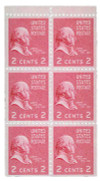
1938 2c John Adams, bklt pane of 6
# 806b - 1938 2c John Adams, bklt pane of 6
$4.25 - $15.75
U.S. #806b
1938 2¢ John Adams
Booklet Pane of 6
Booklet Pane of 6
Issue Date: June 3, 1938
City: Washington, DC
Printed By: Bureau of Engraving and Printing
Printing Method: Rotary Press
Perforations: 11 X 10 ½
Color: Rose carmine
City: Washington, DC
Printed By: Bureau of Engraving and Printing
Printing Method: Rotary Press
Perforations: 11 X 10 ½
Color: Rose carmine
This booklet pane of six John Adams stamps was part of the Presidential Series of 1938. The image was modeled after a bust by of Adams in the Senate Gallery. Known affectionately as the “Prexies,” the series is a favorite among stamp collectors.
The series was issued in response to public clamoring for a new Regular Issue series. The series that was current at the time had been in use for more than a decade. President Franklin D. Roosevelt agreed, and a contest was staged. The public was asked to submit original designs for a new series picturing all deceased U.S. Presidents. Over 1,100 sketches were submitted, many from veteran stamp collectors. Elaine Rawlinson, who had little knowledge of stamps, won the contest and collected the $500 prize. Rawlinson was the first stamp designer since the Bureau of Engraving and Printing began producing U.S. stamps who was not a government employee.
John Adams
John Adams was our nation’s second President and one of America’s earliest and most influential patriots. An eloquent author, Adams penned passionate arguments against the English Parliament’s Stamp Act of 1765. The oppressive taxes, which applied to papers and documents produced in the colonies, inflamed a spirit of independence that led to the American Revolution. Adams was a member of the group of young, educated colonials who were instrumental in the fight for democracy, and later played a critical role in forging the new government.
After serving as George Washington’s vice president, John Adams was narrowly elected President in 1797. England and France were at war, and each of the powerful nations hoped to form an alliance with the United States. History credits Adams with heeding Washington’s parting advice to avoid embroiling the young nation in international conflicts. However, the emergence of partisan politics hampered his administration, and Adams was defeated in his re-election attempt
U.S. #806b
1938 2¢ John Adams
Booklet Pane of 6
Booklet Pane of 6
Issue Date: June 3, 1938
City: Washington, DC
Printed By: Bureau of Engraving and Printing
Printing Method: Rotary Press
Perforations: 11 X 10 ½
Color: Rose carmine
City: Washington, DC
Printed By: Bureau of Engraving and Printing
Printing Method: Rotary Press
Perforations: 11 X 10 ½
Color: Rose carmine
This booklet pane of six John Adams stamps was part of the Presidential Series of 1938. The image was modeled after a bust by of Adams in the Senate Gallery. Known affectionately as the “Prexies,” the series is a favorite among stamp collectors.
The series was issued in response to public clamoring for a new Regular Issue series. The series that was current at the time had been in use for more than a decade. President Franklin D. Roosevelt agreed, and a contest was staged. The public was asked to submit original designs for a new series picturing all deceased U.S. Presidents. Over 1,100 sketches were submitted, many from veteran stamp collectors. Elaine Rawlinson, who had little knowledge of stamps, won the contest and collected the $500 prize. Rawlinson was the first stamp designer since the Bureau of Engraving and Printing began producing U.S. stamps who was not a government employee.
John Adams
John Adams was our nation’s second President and one of America’s earliest and most influential patriots. An eloquent author, Adams penned passionate arguments against the English Parliament’s Stamp Act of 1765. The oppressive taxes, which applied to papers and documents produced in the colonies, inflamed a spirit of independence that led to the American Revolution. Adams was a member of the group of young, educated colonials who were instrumental in the fight for democracy, and later played a critical role in forging the new government.
After serving as George Washington’s vice president, John Adams was narrowly elected President in 1797. England and France were at war, and each of the powerful nations hoped to form an alliance with the United States. History credits Adams with heeding Washington’s parting advice to avoid embroiling the young nation in international conflicts. However, the emergence of partisan politics hampered his administration, and Adams was defeated in his re-election attempt









